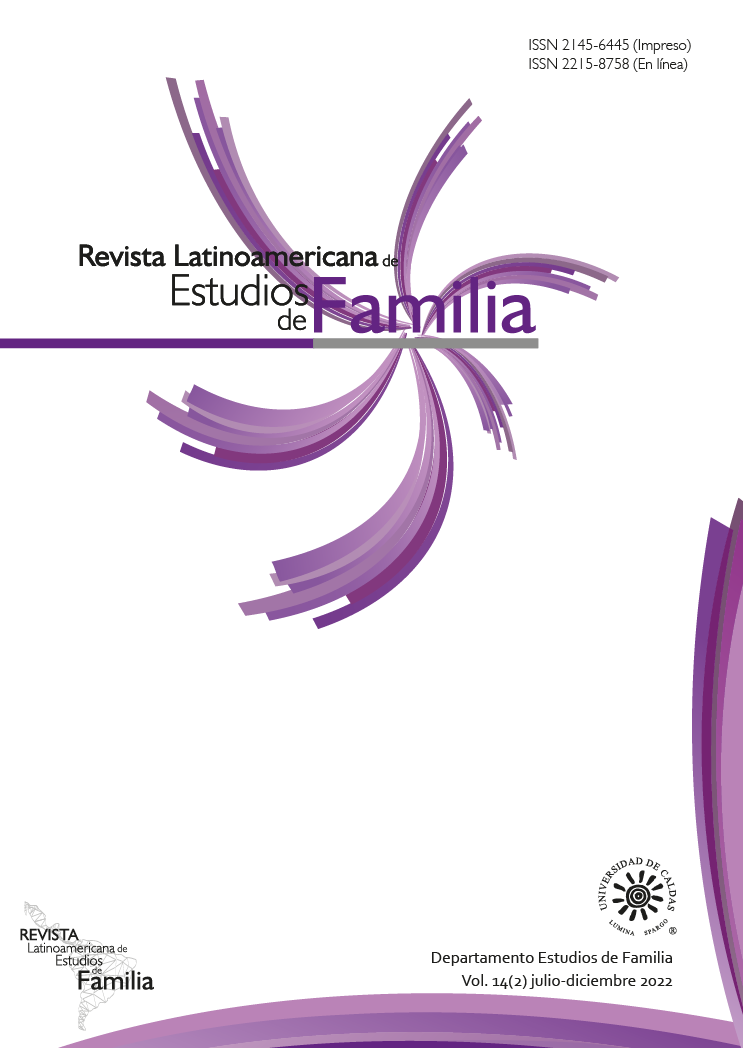Authors
Abstract
Abstract: Objective. To identify the cultural knowledge of suicide that children have in middle childhood, how they know about it, what causes may they attribute to it, the associated emotions and their beliefs for its prevention. Methodology. A total of 59 urban boys and girls between 8 and 11 years old from Guadalajara, Mexico, were interviewed. Results. Most of the participants knew the meaning of the word suicide. They obtained knowledge of suicide through content on the Internet and television. Likewise, the emotional problems in children, emotional abuse in the family and bullying were placed as causes of child suicide. The associated emotions were sadness, anger, and fear. They considered that suicide prevention could be through greater understanding towards the child, greater coexistence, monitoring those at risk of suicide and physically preventing it. Conclusions. It is possible to propose culturally appropriate prevention strategies.
References
Cash, S. J. & Bridge, J. A. (2009). Epidemiology of Youth Suicide and Suicidal Behavior. Current Opinion in Pediatrics, 21(5), 613-619. https://doi.org/10.1097/MOP.0b013e32833063e1
Covarrubias de la Torre, M. G., Soltero Avelar, R., Sánchez Loyo, L. M., Rivera Heredia, M. E. y Pavón Cuellar, D. (2017). Pensamientos de muerte e ideación suicida en niños y niñas mexicanos de 6 a 11 años. Uaricha, 14(32) 20-30. http://www.revistauaricha.umich.mx/ojs_uaricha/index.php/urp/article/view/148
Ferrer, M. y Ruiz, J. A. (2006). Uso de videojuegos en niños de 7 a 12 años. Una aproximación mediante encuesta. ICONO 14, Revista de comunicación y tecnologías emergentes, 4(1), 1-15. https://www.redalyc.org/pdf/5525/552556595018.pdf
Flick, U. (2007). Introducción a la investigación cualitativa (2.a ed.). Morata.
García de Alba García, J. E., Quintanilla-Montoya, R., Sánchez-Loyo, L. M., Morfín López, T. y Cruz Gaitán, J. I. (2011). Consenso cultural sobre el intento de suicidio en adolescentes. Revista Colombiana de Psicología, 20(2), 167-179. https://www.redalyc.org/pdf/804/80421265002.pdf
Gauthier, J. M., Zuromski, K. L., Gitter, S. A., Witte, T. K., Cero, I. J., Gordon, K. H., Ribeiro, J., Anestis, M. & Joiner, T. (2014). The interpersonal-psychological theory of suicide and exposure to video game violence. Journal of Social and Clinical Psychology, 33(6), 512-535.
https://doi.org/10.1521/jscp.2014.33.6.512
González-Forteza, C., Villatoro Velázquez, J., Alcántar Escalera, I., Medina Mora, M. E., Fleiz Bautista, C., Bermúdez Lozano, P. y Amador Buenanab, N. (2002). Prevalencia del intento suicida en estudiantes adolescentes de la ciudad de México 1997 y 2000. Salud Mental, 25(6), 1-12. http://www.uade.inpsiquiatria.edu.mx/pagina_contenidos/publica_articulos/salud_mental_27.pdf
Guitart, M. E. (2008). Hacia una psicología cultural. Origen, desarrollo y perspectivas. Fundamentos en Humanidades, 9(18), 7-23.
https://www.redalyc.org/articulo.oa?id=18411970001
Instituto Federal de Telecomunicaciones. (2017). Encuesta Nacional de Consumo de Contenidos Audiovisuales. Ciudad de México, México: Instituto Federal de Telecomunicaciones. http://www.ift.org.mx/sites/default/files/contenidogeneral/comunicacion-y-medios/encca2017191218vf.pdf
Instituto Nacional de Estadística y Geografía (INEGI). (2018). Estadísticas de suicidios en México.
http://www.beta.inegi.org.mx/proyectos/registros/vitales/mortalidad/default.html
Instituto Nacional de Estadística y Geografía (INEGI). (2019). Estadísticas a propósito del día mundial para la prevención del suicidio (10 de septiembre). Comunicado de prensa núm. 455/19. Ciudad de México, México: Instituto Nacional de Estadística y Geografía.
Järvinen, M., & Mik-Meyer, N. (2020). Analysing qualitative data in social science. En: M. Järvinen, & N. Mik-Meyer (Eds.), Qualitative Analysis: Eight approaches for the social sciences (pp. 1-28). Sage Publishing.
Joiner, T. (2005). Why People Die by Suicide. Harvard University Press.
Klomek, A. B., Sourander, A., Niemela, S., Kumpulainen, K., Piha, J., Tamminen, T., Almqvist, F. & Gould, M.S. (2009). Childhood bullying behaviors as a risk for suicide attempts and completed suicides: a population-based birth cohort study. Journal of the American Academy of Child & Adolescent Psychiatry, 48(3), 254-261. https://doi.org/10.1097/CHI.0b013e318196b91f
Mead, G. H. (1968). Espíritu, persona y sociedad desde el punto de vista del conductismo social. Paidós.
Mejía-Arauz, R., Dávalos Picazo, G., Zohn Muldoon, T. (2020). Organización de vida cotidiana de familias cuyas madres tienen trabajo remunerado. Estudio en cinco grupos socioculturales. En R. Mejía-Arauz (ed.), Organización familiar en la vida urbana: un análisis de su impacto en el desarrollo en la infancia media (pp. 77-110). Universidad ITESO.
Miranda de la Torre, I., Cubillas Rodríguez, M. J., Román Pérez, R. y Valdez, E. A. (2009). Ideación suicida en población escolarizada infantil: factores psicológicos asociados. Salud Mental, 32(6), 495-502. http://www.scielo.org.mx/pdf/sm/v32n6/v32n6a7.pdf
Mishara, B. (1999). Conceptions of death and suicide in children ages 6-12 and their implications for suicide prevention. Suicide and Life-Threatening Behavior, 29(2), 105-118. https://doi.org/10.1111/j.1943-278X.1999.tb01049.x
Morfín-López, T. y Sánchez-Loyo, L. M. (2015). Violencia doméstica y conducta suicida: relatos de mujeres sobre la violencia y sus efectos. Acta Universitaria, 25(2), 57-61. https://doi.org/10.15174/au.2015.886
Morfín-López, T. y Sánchez Loyo, L. M. (2016). Diferencias generacionales en la expresión de emociones ante el suicidio de adolescentes. En O. López Sánchez, y R. Enríquez Rosas (eds.), Cartografías Emocionales: Las Tramas de la Teoría y la Praxis (pp. 189-204). UNAM-ITESO.
Morfín-Otero, F. (2020). La familia en la red. En R. Mejía-Arauz (ed.), Organización familiar en la vida urbana: un análisis de su impacto en el desarrollo en la infancia media (pp. 257-282). Universidad ITESO.
Nock, M. K. & Kazdin, A. E. (2002). Examination of affective, cognitive, and behavioral factors and suicide-related outcomes in children and young adolescents. Journal of Clinical Child and Adolescent Psychology, 31(1), 48-58. https://doi.org/10.1207/S15374424JCCP3101_07
Organización Mundial de la Salud (OMS). (2014). Prevención del Suicidio un Imperativo global. Organización Panamericana de la Salud. https://apps.who.int/iris/bitstream/handle/10665/136083/9789275318508_spa.pdf
Panagiotaki, G., Nobes, G., Ashraf, A. & Aubby, H. (2015). British and Pakistani children’s understanding of death: Cultural and developmental influences. British Journal of Developmental Psychology, 33(1), 31-44. https://doi.org/10.1111/ bjdp.12064
Quintanilla-Montoya, R., Sánchez-Loyo, L. M. y Pérez-Lúa, I. A. (2015). Conceptos de muerte y suicidio en una muestra de menores mexicanos de 5 a 14 años de edad. Acta Universitaria, 25(2), 24-28. https://doi.org/10.15174/au.2015.887
Saldaña, J. (2016). The coding manual for qualitative researchers. Sage.
Sánchez-Loyo, L. M., García de Alba, J. E. y Quintanilla-Montoya, R. (2016). Características sociales y clínicas de personas con intento de suicidio en Guadalajara, México. Psicología y Salud, 26(1), 81-90. http://revistas.uv.mx/index.php/psicysalud/article/view/1901/3477
Sánchez-Loyo, L. M., Morfín-López, T., Quintanilla-Montoya, R., García de Alba García, J. E., Cruz-Gaitán, J. I., Hernández Millán, R. y Contreras-Preciado, E. (2014). Intento de suicidio en adolescentes mexicanos: perspectiva desde el consenso cultural. Acta de Investigación Psicológica, 4(1) 1446-1458. https://doi.org/10.1016/S2007-4719(14)70386-2
Sato, P. M. (2010). Violencia simbólica en video juegos. Cuadernos de la Facultad de Humanidades y Ciencias Sociales - Universidad Nacional de Jujuy, (38), 169-179.
Schwartz, K. A., Pyle, S. A., Dowd, M. D. & Sheehan, K. (2010). Attitudes and beliefs of adolescents and parents regarding adolescent suicide. Pediatrics, 125(2) 221-227. https://doi.org/10.1542/peds.2008-2248
Slaughter, V. & Griffiths, M. (2007). Death understanding and fear of death in young children. Clinical Child Psychology and Psychiatry, 12(4), 525-535. https://doi.org/10.1177/1359104507080980
Sooles, R., Kolves, K. & De Leo, D. (2015). Suicide in Children: A Systematic Review. Archives of Suicide Research, 19(3), 285-304. https://doi.org/10.1080/13811118.2014.996694
Stubbing, J. & Gibson, K. (2019). Young people’s explanations for youth suicide in New Zealand: a thematic analysis. Journal of Youth Studies, 22(4), 520-532. https://doi.org/10.1080/13676261.2018.1516862
Schütz, A. (1962). El problema de la realidad social. Amorrortu.
Schütz, A. (1972). Fenomenología del mundo social. Paidós.
Schütz, A. (1974). Estudios sobre teoría social. Amorrortu.
Teismann, T., Förtsch, E. M. A., Baumgart, P., Het, S. & Michalak, J. (2014). Influence of violent video gaming on determinants of the acquired capability for suicide. Psychiatry Research, 215(1), 217-222. https://doi.org/10.1016/j.psychres.2013.10.021
Tishler, C. L., Reiss, N. S. & Rhodes, A. R. (2007). Suicidal behavior in children younger than twelve: a diagnostic challenge for emergency department personnel. Academic Emergency Medicine, 14, 810-818. https://doi.org/10.1111/j.1553-2712.2007.tb02357.x
Vygotski, L. S. (1993). Pensamiento y lenguaje. En L. S. Vygotski (ed.), Obras Escogidas, Tomo II (pp. 9-348). Aprendizaje Visor.
Vygotski, L. S. (1994). The problem of the environment. In R. van der Veer & J. Valsiner (eds.), The Vygotsky reader (pp. 338-355). Blackwell.
Vygotski, L. S. (1996). El problema de la edad. En L. S. Vygotski (ed.), Obras Escogidas, Tomo IV (pp. 251-273). Aprendizaje Visor.
Vygotski, L. S. (2007). Psicología del arte. Fundación Infancia y Aprendizaje.
Viñas, F. y Doménech, E. (1999). El concepto de muerte en un grupo de escolares con ideación suicida. Revista de Psicología General y Aplicada, 52(1), 89-104. https://dialnet.unirioja.es/servlet/articulo?codigo=2498256
Winterrowd, E., Canetto, S.S. & Benoit, K. (2017). Permissive beliefs and attitudes about older adult suicide: a suicide enabling script? Aging & Mental Health, 21(2), 173-181. https://doi.org/10.1080/13607863.2015.1099609

 PDF (Español)
PDF (Español)
 FLIP
FLIP

























